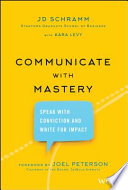

Clarity is the cornerstone of effective communication. This principle emphasizes that when conveying ideas, it is crucial to articulate thoughts in a straightforward manner, avoiding jargon and complex language that may confuse the audience. Clear communication fosters understanding and engagement. The book discusses techniques for simplifying messages, such as using concrete examples, breaking down complex ideas into digestible parts, and ensuring that the audience can relate to the content. By prioritizing clarity, communicators can enhance their credibility and ensure their messages resonate with listeners.
Continue readingEffective communication is not just about delivering a message; it also involves understanding the audience's needs, preferences, and backgrounds. The book highlights the importance of audience analysis, which includes researching who the audience is, what they value, and how they prefer to receive information. This understanding allows communicators to tailor their messages accordingly, making them more relevant and impactful. Techniques such as audience segmentation and feedback loops are discussed, emphasizing that knowing your audience can lead to more successful interactions.
Continue readingStorytelling is a powerful tool in communication that can captivate and engage an audience. The book elaborates on how narratives can be used to illustrate points, evoke emotions, and create a connection with listeners. It discusses the elements of effective storytelling, such as structure, character development, and emotional resonance. By incorporating stories into their communication, individuals can make their messages more memorable and persuasive. The author provides examples of successful communicators who have utilized storytelling to enhance their impact.
Continue readingNon-verbal cues significantly influence how messages are received. This idea explores the various forms of non-verbal communication, including body language, facial expressions, and tone of voice. The book emphasizes that being aware of these cues can enhance a communicator's effectiveness. It discusses how congruence between verbal and non-verbal messages can reinforce a speaker's credibility and the importance of being mindful of one's own non-verbal signals. The author provides practical tips for improving non-verbal communication skills to support verbal messages.
Continue readingActive listening is a crucial component of effective communication that involves fully engaging with the speaker and demonstrating understanding. The book discusses techniques for improving active listening skills, such as maintaining eye contact, providing feedback, and asking clarifying questions. By practicing active listening, individuals can foster better relationships and ensure that they accurately interpret the messages being conveyed. The author argues that active listening not only enhances communication but also builds trust and rapport between parties.
Continue readingFlexibility in communication style is essential for effective interactions. This principle highlights the importance of adapting one's approach based on the context and the audience. The book discusses various communication styles and how they can be adjusted to suit different situations, whether in a formal presentation or a casual conversation. It encourages readers to develop a range of communication strategies and to be mindful of the dynamics of each interaction. By being adaptable, communicators can better connect with diverse audiences and achieve their communication goals.
Continue readingFeedback is a vital component of the communication process that helps individuals improve their skills and effectiveness. The book explores the different types of feedback, including constructive criticism and positive reinforcement, and how they can be delivered effectively. It emphasizes the importance of creating a feedback-rich environment where individuals feel comfortable both giving and receiving feedback. The author provides strategies for soliciting feedback and using it to refine communication skills, ultimately leading to more successful interactions.
Continue reading